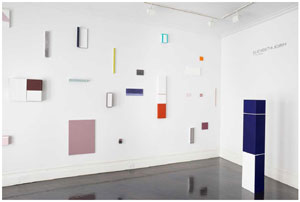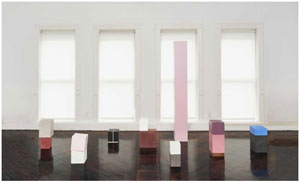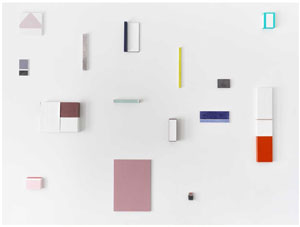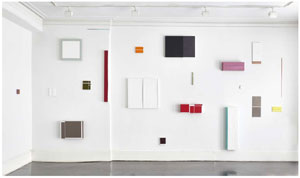Serviços Personalizados
Journal
artigo
Indicadores
Compartilhar
Trivium - Estudos Interdisciplinares
versão On-line ISSN 2176-4891
Trivium vol.10 no.1 Rio de Janeiro jan./jun. 2018
https://doi.org/10.18379/2176-4891.2018v1p.126
ARTES
A Constructivist Diagram: Elizabeth Jobim's Archaeology of Abstract Forms*
Um Diagrama Construtivista: arqueologia das Formas Abstratas de Elizabeth Jobim
Un diagrama constructivista: la arqueología de Elizabeth Jobim de las formas abstractas
Juan Ledezma
PhD in the History of Western Art (20th and 21st centuries) from Columbia University. Independent scholar and curator specialized in the Russian avant-garde and Latin American modern and contemporary art. E-mail: ledezma.juan@gmail.com
The square is no longer an approximation to nothingness. Now the square has a history of its own.
Elizabeth Jobim, 2017
If concepts can be visual or visuality conceptual, it might be said of Elizabeth Jobim's recent artistic output that it provides a visual concept of disjunction. Her works-a pinkish monochrome, for instance, whose uninflected surface maximizes the optical brunt of the slash that halves it; an all-white rectangle, also sliced in two so as to allow for a vertical glimpse of the black layer beneath it; or a deep-red solid, one section of which appears to have been cropped out and hangs suspended in midair-propose that the acts of cutting, cropping and disjointing be considered more than technical expedients. Jobim's works propose the disjunctive cut, performed either through actual slices or dislodging lines, as a mode of fracturing their contained autonomy and invoking relations between segments of sub-segments, tidbits slivered from already broken parts. The result might be described as a shifting diagram: arranged across a wall, these works relate among themselves and others to form a sprawling network of connections that viewers can chart in ever renewable fashions, depending on how they choose to distribute their inspecting gaze.
In the process, centrally, viewers are bound to conclude that the gap between the displayed works, crisscrossed as it is by diagrammatic connections, is not only spatial but also temporal. The gap is, in fact, historical. History informs, for instance, the space between works that resonate with the activation of the pictorial object proposed by Willys de Castro in the late 1950s and others that arch back to Lygia Pape's Tarugos. In general, though marked by the experimental traits of recentness and staking, therefore, a well-grounded claim to contemporaneity, Jobim's abstract painting projects a retrospective condition that could be expanded to include more distant connections-Unism, most probably, among other avatars of Constructivism understood in a broad sense-yet consistently narrows down to the renewed modality of concrete abstraction that Rio de Janeiro artists practiced in the mid-twentieth century.
Such an emphasis is key. Jobim retrieves from the legacy of Neo-Concrete abstraction formal expedients that, as rehearsed by De Castro, Pape, and Lygia Clark, among others, prompted the critic Ferreira Gullar to formulate the notion of the non-object as a temporal compound of shifting relations, markedly different from objects confined to the fixed space of their arrested existence. Yet in retrieving, Jobim reconstructs. The artist reclaims her country's modernist legacy from a standpoint that, as observed, substitutes historicity for temporality. Inscribed within a network-and hence extricated from their isolated, autonomous space-these works exist only in their relations with one another, yet such relations are now saturated by historical memory. They are fraught with a mnemonic load that prevents perceiving the fracturing disjunctions that operate within the works only as the phenomenal modifications of form. So it is that such disjunctions can no longer be either grasped or theorized, as they were in the 1950s, from the vantage of a phenomenological gaze.
Perceiving Jobim's neo-abstract works demands the formation of another perspective. It involves the postulation of a constructivist diagram through which forms would be examined in their presentness, as themselves, and under the modality of their retrospective thrust, as documents of past constructions that summon an archaeological interpretation of sorts. This summons is keenly perceptible as Jobim's pictures, which characteristically protrude from the wall to allow for their lateral inspection, are deployed freestanding within the site of exhibition. The experience of walking around what the artist calls Blocos (Blocks), columnar structures often arranged in packed maze-like configurations, has been recounted as coming across the dislocation of painting: when seen at close range, Jobim's Blocos flatten out into pictorial surfaces that regain their volumetric presence as viewers step away, so that "painting"-conventionally the flat, frontal extension of line, texture, and color-is alternately encountered and lost from sight, subjected to the operations of such inclusive disjunctions as picture or sculpture, color or space. Yet it is the set of historical references to be detected in the Blocos that most forcefully confounds the experience of painting as such. Strict medium-specificity is lost, for one thing, to the phenomenological unfolding of the layout, which progressively wells up to provide viewers with a thickened awareness of the interrelation between color and its spatial, when not architectural, context. For another, such an unfolding of the distinct Blocos as an integrated corpus of sensations is also compromised, this time by a disjunction that overrides the others: contemporaneity or modernity, the sheer brunt of immediate experience or history's blunt mediations.
The two alternatives are inextricable from one another; the disjunctions are categorically inclusive. Indeed, Jobim's variously disjunctive work in part grounds its contemporary condition in the capacity to engage its legacy. The artist's stated acknowledgement that emblematic abstract forms have a history of their own, so that abstraction can no longer provide access to the trans-historical space of either sensorial plenitude or cognitive nothingness, links her constructions to those of other Latin American artists whose current work also integrates the realization that abstraction's language is irremediably double. Non-discursive by definition, this language now reemerges as tinged by the discourse accumulated around it, and in the region this entails that abstraction is pervaded by the redemptive statements, the promissory utterances of a long past developmentalist discourse. Here again, Jobim resorts to strategies that make her proposal unique. For in the midst of her constructivist diagram the object reappears-not modernism's theoretical objects, nor the historicist constructions of contemporary art, but things under their most simple, ordinary guise: unbalanced stacks, makeshift assemblages that propose a constructivism of the precarious, the fragile, or the mundane. Against the backdrop of abstraction's rehearsed possibilities, these objects bear an unforeseen potential: the confrontation of the historical subject with the recalcitrant silence of things, waiting to be reclaimed by a discourse yet to be pronounced.
Recebido em: 27/12/2017
Aprovado em: 03/03/2018
* Galeria Henrique Faria, Nova York, 2017.


















